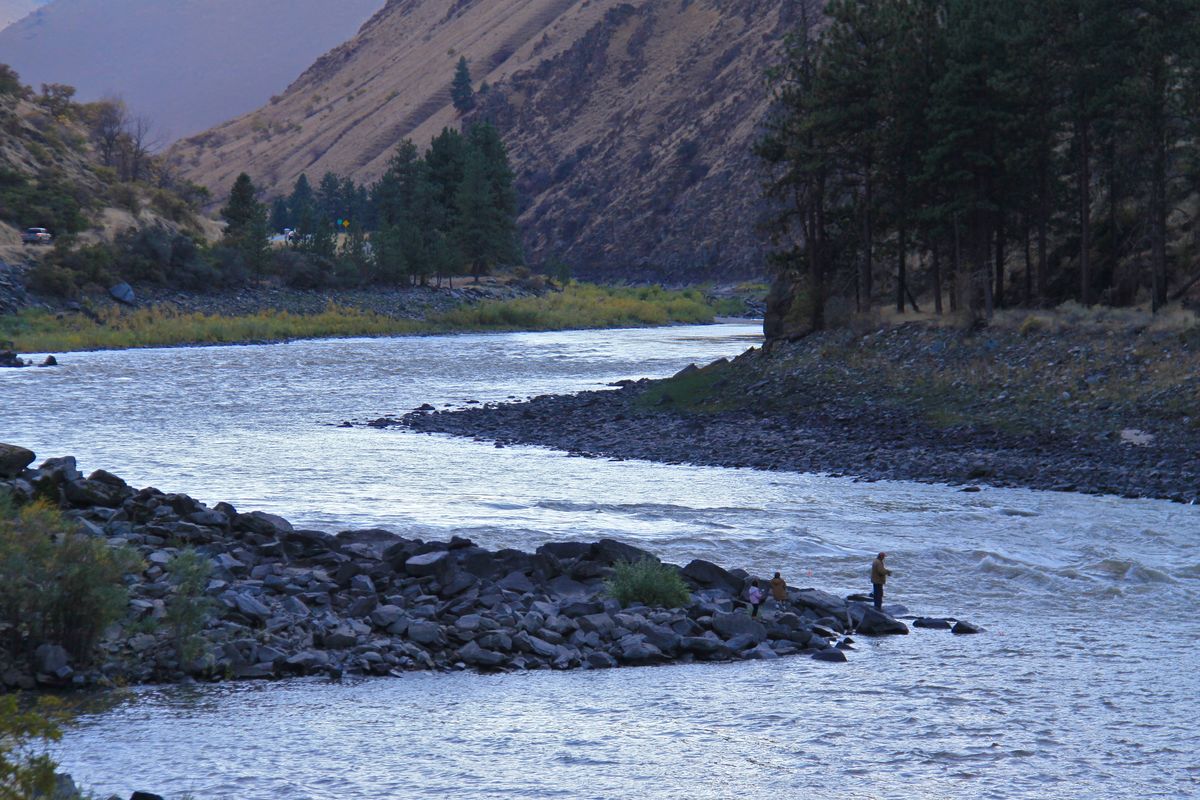Spinning for steelhead effective, but often overlooked

The bright orange and brass spoon wobbled only for a few seconds along an eddy line in the Salmon River when it stopped dead.
Then, line began peeling off my level-wind reel at a sizzling speed as the drag sang.
“Steelhead on!” I yelled up the beach. My wife got the net out of the drift boat.
We had been pulling plugs from the boat, but I wanted to mix it up with a little spoon fishing while we stopped on a sandbar for lunch.
The steelhead made a run downstream and so did I, leaving a trench of deep footprints in the soft sand.
After a 15-minute battle that took me up and down the beach, the beautiful keeper steelie was in the net.
Fishing for steelhead with spoons and spinners is exciting but often ignored by anglers.
Plugs and bait
Some anglers get bored pulling plugs in a drift boat. Others don’t want to mess with bait, such as drifting shrimp. Others haven’t taken the time to learn, or get outfitted, for fly fishing.
For a change of pace, that leaves tossing spoons and spinners for these rainbow-colored sea-run giants that migrate hundreds of miles to spawning grounds in Idaho’s rivers.
From the boat
You can be both a plug and spinner or spoon angler. Some anglers keep two fishing rods in the drift boat. One has a plug on it and the other a spinner or spoon.
If you finish plugging or Hotshotting an area and plan to drift downstream to another plug- pulling area, don’t quit fishing. Pick up the spoon rod and cast and retrieve as you drift. You never know. Catching takes having a line in the water.
Starting out
“Spoons are an art form,” says Carmen Macdonald, a veteran salmon and steelhead angler and representative for Luhr Jensen lures.
“There’s a pretty simple goal. You want to get the lure in the strike zone,” says Macdonald, who is familiar with Idaho’s Salmon River.
When it comes to fishing spoons and spinners, you’ve got to pick apart the river pretty much the same way as plug and fly anglers.
Rivers, like the salmon, pretty much have the same characteristics up and down the waterways.
You’ve got rapids and a pool with a bunch of roily water. Then it mellows out with a nice stretch of flatwater 4 to 8 feet deep above the tailout. The water just off the bottom in that flat section is the strike zone. The tailout is the calm-water area at the horizon line just before another set of rapids or riffle.
Both the stretch of flatwater and tailout are prime locations to fish.
“Day in and day out those flats will hold fish,” says Macdonald.
A lot of anglers also catch fish in the tailout, especially the first thing in the morning when fish are holding in that part of the river.
River current
The key to fishing spoons and spinners is the speed of the river’s current. You want walking-speed current, Macdonald says.
Anglers also need to get the lure within a couple of feet off the bottom of the river in the strike zone.
It takes just the right kind of cast to do it. OK, start out in that nice stretch of flat water after the rapids. Look straight across the river at a right angle to the river bank.
Don’t cast straight out. Look at the depth of the river first.
In shallow water, the lure will sink into the strike zone more quickly so you want to make your cast with more of a downstream angle, say around 45 degrees.
If you cast too far upstream in shallow water, you’ll get hung up quickly and lose a $3 to $4 lure.
The deeper the water, the more upstream you want to cast so the lure has enough time to sink down into the strike zone before it begins to swing in the current. Adjust your cast maybe slightly less than a 45-degree angle upstream.
Adjusting your casts takes practice and maybe losing a few bucks worth of lures.
Easy going spinners
Spinners are easier to fish than spoons. You have to make sure you cast it properly and get it swinging in the current and going into the strike zone.
All you have to do is reel in the proper speed to have it make a good swing. The spinning blade produces the flash and action. So, if you are just starting out fishing hardware, spinners will do the trick.
“Spoons are more challenging and more rewarding,” says Macdonald. “A good spoon angler takes into account water depth and speed.”
You’ve got to feel the wobble. If you just throw the spoon upsteam with a slack line. The spoon will sink like a rock.
Cast out and tighten up on the line just enough to feel the wobble. You can also let line out to get the spoon to flutter into the strike zone.
Watch your rod tip. If it is vibrating as the spoon drifts, the spoon is working properly.
“Don’t overwork the spoon,” he says. The wider the spoon, the more action. The thinner the spoon, the more current is needed for the action.
“It’s a wonderful way to fish and the rewards are incredible,” Macdonald says.
However, if Macdonald had one lure to choose, it would be a spinner.
“It’s got flash and vibration and it’s easy to use,” he says.